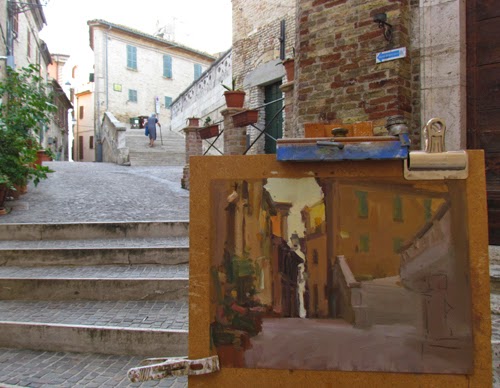I was recently asked by a student, "Why Plein Air?"
It didn't take long for me to respond and I thought I would share it here as well. During a recent trip to Italy this happened to take place while out on location.
This is the initial jumping off point, the scene itself. Monteprandone Italy August 2014
This is a sketch I did a few days earlier while snooping around the town.
There were two figures chatting which was initially part of the drawing as well as the vertical format versus the horizontal one that I ended up using.
Step
The charcoal layout of shapes and design. This was painted on a plein air carton panel which is reminiscent of those used by Toulouse- Lautrec and Vuillard, but a whole lot more archival. Great for traveling with. (Judson Outfitters product line)
Massing in all of the patterns and values. You'll notice that my initial idea was to utilize the wrought iron gate on the right. As much as I like to use elements to help lead the viewer into my scene I did find that it was overpowering as well as competing with the focal point, and later decided to remove it all together after 3 or 4 times of varying its size and design.
To me everything comes back to design.
It has taken me many years, over 23 to be exact of doing plein air, to realize the importance of that. As much as I pull from the scene I do not want to be a slave to it, always looking to simplify and enhance the overall of what first grabbed me.
Here is one of the attempts at resolving the gate area. Pushing it further off to the right.
This is where it all seems to happen and what I truly love about plein air. That is the happy accidents that seem to take place. Never seems to fail.
I began this business many years ago doing watercolors under Irving Shaprio at the American Academy of Art in Chicago, and in my heart of hearts still proceed in my work somewhat like that of a watercolorist.
Be it the changing light which is always a challenge but with that is also a blessing due to the shapes and designs that it continually creates. Or as in this case having a figure that appears and casually walks into your scene.
I usually try not to chase the light after realizing that first "light - shadow" pattern that I was first drawn to but again always being open and receptive to any improvements and possibilities that may arise, again part of the charm of plein air versus using a photo that is stagnant.
However with that being said a camera is a wonderful tool we have at our disposal to help us grab those fleeting moments, always keeping them in mind for a later studio version.
"La Strada Vicino la Cheisa" 9 x 12 oil on panel.
In this case I chose to leave the figure out but was happy she passed through. Sometimes a scene is better served without a figure which can over power it if it is not planned into the original idea, and other times it is a wonderful addition. I left this one for the studio.
For me as much as there are many elements in dealing with the great outdoors, be it cold winter plein air scenes, bugs, wind, changing light, or other hardships that arise, what really appeals to me with plein air is this wonderful happen chance that always presents itself, again as long as we are open and receptive to it and not closed off on what we think we are after.
I always start out every workshop by saying that when going out on location you really should always be willing and ready to change your initial plan. We don't need to have a back plan or audible per se but definitely ready and willing to change.
This hits right along that cord.
When written in Chinese the word crisis is composed of two characters.
One represents danger, and the other represents opportunity.[3]
One represents danger, and the other represents opportunity.[3]
Remarks by President Kennedy[dead link] at the Convocation of the United Negro College Fund
With every change and risk there is an opportunity.
Plein air baby!
This is the follow up version back at the studio. Notice the end cap on the right hand side has been added back into the scene, go figure.
"La Vecchia" 18" x 24" Oil on Linen Panel










